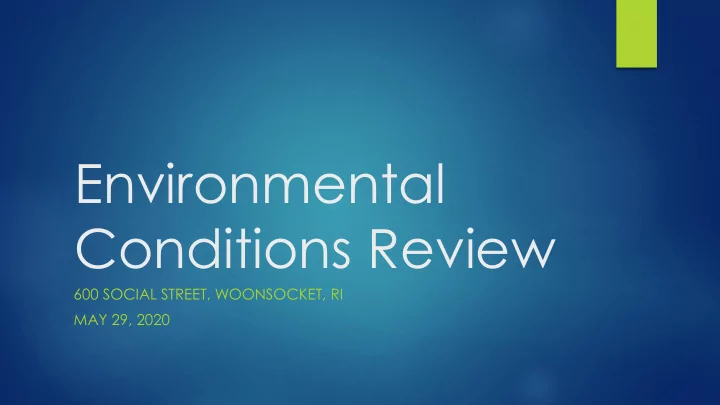

Environmental Conditions Review 600 SOCIAL STREET, WOONSOCKET, RI MAY 29, 2020
Regulatory Framework RIGL Chapter 23-19.14 (The Industrial Property Remediation and Reuse Act) Section 23-19.14-5 (Environmental Equity and Public Participation) Applies to locations within Environmental Justice Areas and those intended for redevelopment as a child-care/recreational facility.
Boys & Girls Clubs of Northern Rhode Island (BGCNRI) Mission & Background The Boys & Girls Clubs of Northern Rhode Island (BGCNRI)’s mission is “to enable all young people, especially those who need us most, to reach their full potential as productive, caring, responsible citizens. ”At our facilities and through outreach, BGCNRI constantly strives to provide a positive environment with programs and services focusing on three core areas – academic success, healthy lifestyles, and good character and citizenship - that are integral to Northern Rhode Island youth. Now in its 64th year, BGCNRI serves children and youth from Woonsocket, Cumberland, Lincoln, and the surrounding communities. Annually, BGCNRI serves 4,851 unique members and 644 through outreach programs; 430 youth are served daily through our Teen Centers, as well as before & after-school programs. In 2019, BGCNRI served 33,304 meals and snacks at our Cumberland Clubhouse, and 46,674 meals and snacks at our Woonsocket Clubhouse, a total increase of over 14,000 compared to 2018. BGCNRI's Woonsocket Clubhouse in particular faces a magnified disadvantaged youth community, where approximately 85% of members are in single family households and 95% qualify for free or reduced lunch. BGCNRI serves an average of 158 members daily who face poverty, high drop-out rates, gang-involvement, and substance abuse. According to the 2020 Rhode Island Kids COUNT Factbook, the median family income in Woonsocket was $31,914 in 2018, the second lowest in the state. Only 74% of Woonsocket students graduated from high school in 2019, as compared to the 84% state average, and Woonsocket holds the fourth highest drop-out rate in the state. Also disheartening, in 2019, the city had the highest rate of child victims of abuse and neglect in the state (32.7 victims per 1,000 children). In the past two years, 100% of High School Seniors who were active members of our Woonsocket clubhouse graduated high school.
New Facility Key Points The proposed new facility at 600 Social Street in Woonsocket would replace our current location at 72 Kendrick Avenue. This new facility would allow BGCNRI to serve as many as 500 youth per day (300 youth ages 5-12, and 200 teens ages 13-18). Plans for the new building include separate indoor gym space for both youth and teens, as well as a state-of-the-art learning kitchen. The learning kitchen will allow BGCNRI to increase our ability to teach families the fundamentals of preparing healthy, cost- effective meals, and the importance of living a healthy lifestyle. The 600 Social Street facility will create numerous job opportunities, career development programs, financial literacy learning, as well as additional Youth Employment staffing positions, all while helping our youth build “great futures” for many years to come.
600 Social Street
Environmental Assessment Environmental Transaction Screen Assessment (TSA) Occurred in April 2018 Key Historical Findings Site was developed as early as 1892; Occupants of Site-wide structures included: Residences and general stores including (restaurants, bakery, hotel, grocers, etc … ) Current Site structure built during the mid-1980s; Utilized as an athletics club. Site structure is connected to municipal water, sewer, and heated with natural gas.
Environmental Assessment As part of general due diligence in preparation of Site redevelopment, subsurface sampling of soil and groundwater was performed. Soil Findings – lead, total petroleum hydrocarbon (TPH), and select poly-nuclear aromatic hydrocarbons (PAHs) in excess of RIDEM Direct Exposure Criteria and/or Groundwater Leachability Criteria. Groundwater Findings – no target compounds in excess of applicable GB Groundwater Objectives
Proposed Response Actions Install a site-wide cap to prevent direct soil contact Capping will consist of presumptive measures such as: Existing building footprint/slab and pavement; Landscape/Earthen Areas – 12 ” of clean cover upon a geotextile liner; and New Pavement/Hardscape – 6 ” of clean subgrade with 4 ” pavement/hardscape cover. File a site-wide Environmental Land Use Restriction (ELUR) with Soil Management Plan to maintain controls and require yearly inspection of the Site.
Next Steps Complete the public comment period Prepare and submit to RIDEM the Site Investigation Report Public comments should be directed to: Michelle L. DeBlasio Environmental Engineer RI Department of Environmental Management Office of Waste Management / Site Remediation 235 Promenade Street Providence, RI 02908 michelle.deblasio@dem.ri.gov (401) 222-2797 ext. 7158
Questions?
Recommend
More recommend